Just where does American agility stand?
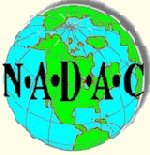 Anne A.
Smith wrote this article for her club newsletter a few weeks ago, comparing the American
Agility to the rest of the world. What do you think? Anne A.
Smith wrote this article for her club newsletter a few weeks ago, comparing the American
Agility to the rest of the world. What do you think?
The Brits invented Agility in the late 70’s, with the
debut at Crufts, but its origins undoubtedly were horse-related, some say to the cross country
phase of eventing, and others say to the stadium (or show) jumping phase. Whatever, the Brits
led the sport.
In the early 80’s Ken Tatsch and Jean MacKenzie were
among those to take a judging exam in England under Peter Lewis, and they passed with honors
(honours!). Ken soon began the sport here, as the United States Dog Agility Association (USDAA).
The North American Dog Agility Council (NADAC) began a few years later, as an offshoot of the
USDAA spearheaded by Sharon Nelson. The first American Kennel Club (AKC) national competition
coincided with the USDAA Nationals in Houston at the Astrodome in 1994.
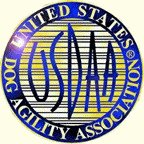 The
USDAA set the standards early in US agility history with distance handling exemplified by J.C.
Thompson of North Carolina, who led the scene with his Border Collie, Robbie. Gamblers classes
encouraged this type of handling. Over the years, however, it became clear that distance
handling was not particularly important in the rest of the world where handlers tended to run
(fast!) with their dogs. The
USDAA set the standards early in US agility history with distance handling exemplified by J.C.
Thompson of North Carolina, who led the scene with his Border Collie, Robbie. Gamblers classes
encouraged this type of handling. Over the years, however, it became clear that distance
handling was not particularly important in the rest of the world where handlers tended to run
(fast!) with their dogs.
The American Concept of Agility
The US has evolved its own particular brand of Agility. The three sponsoring organizations
mentioned above have their disagreements, but there is one thing on which all agree. The
American concept of titles works. Titling involves passing a set of standards in order to
go onto the next level, in much in the same way that the Pony Club (British Horse Society)
rating systems operates.
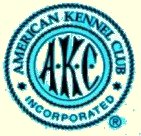 The
only other countries that I know of that have titles, as we understand them, are Australia and
New Zealand. Others have systems of advancement for moving from one level to another that may
require wins. In Britain it requires a win (except at elementary level in which the top three
placements count) out of hundreds of dogs. The
only other countries that I know of that have titles, as we understand them, are Australia and
New Zealand. Others have systems of advancement for moving from one level to another that may
require wins. In Britain it requires a win (except at elementary level in which the top three
placements count) out of hundreds of dogs.
I think we’re the only nation to allow dogs to
participate at four jump heights. In the UK any dog over 17" at the withers must jump 30". We
tend to think that is detrimental to the dogs' health, although there are as yet no studies to
prove it. We prefer to keep Agility a family sport in which almost anyone and any dog can
participate, have fun, and perhaps even get a leg, depending upon the organization.
Three Legs Make a Title
Ken Tatsch originated the Titling Program, which includes three clear Standard Runs generally
consisting of 20 obstacles plus Qualifying Runs in Snooker, Pairs, Jumpers, and Gamblers. This
is called the Masters Program. All other USDAA programs are modifications of it.
The Brits, who invented snooker - based upon the billiard
game that can be seen endlessly on the telly late at night - play a very simple version of it
and only occasionally. They seem rather surprised to see it as a requirement for a MAD (Master
Agility Dog), but that's how we have adapted and enlarged upon it.
AKC has initiated a Jumpers and Weaves class which is
closer to the British Jumping class, which includes weave poles. In most countries, Agility is
regulated by the ruling national kennel club, most of which allow mixed breeds to compete. A
New Zealand correspondent adds, 'In fact, they normally beat the rest of us!'
Nowhere that I know of do you find what we have: three
autonomous organizations! Despite our differences, there is a definite American flair about the
whole thing.
 So How Do We Stand?
So How Do We Stand?
Well, obviously not too badly, since our AKC mini team won the world championship last year.
Where do the Brits stand? We don't know since their quarantine laws do not allow them to
participate outside of their own country. Given the philosophical differences between their
goals and ours, it seems to boil down to speed versus control.
First Past the Post
Since speed is not the primary goal in our titling programs, our courses tend to be
quite technical. UK courses, based upon speed, tend to be simpler. Sally Jones, a British email
friend told me, 'That's why I love your titling system. If we didn't have to go so bloody fast,
we could prove ourselves in all disciplines. From what I saw at the USDAA Nationals last year,
the American dogs are far more accurate on contacts than the majority of ours. In fact, they
were really impressive. But they are far, far slower. Some of the dogs in the Nationals would
still be in Starters over here. I am a control freak, so I would like to compete in the US,
especially as you have a 26" division. With classes at the larger trial up to 700 dogs
sometimes I think courses are designed to be quick and simple so that they get get through all
the dogs in one day.'
Pascal Peng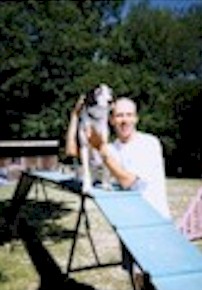
In 1996, Pascal Peng (left), a well known Swiss trainer, came to the autumn USDAA trial
and brilliantly ran my dog Sid, Monica Percival's Lazer, Jean MacKenzie's Brownie and Joe
Winslow's Shadowfax. He returned to do clinics in 1997 and 1998, and will be on the Cleanrun
Camp staff in 2000.
He commented, 'You are not running for the first place,
but rather for the 'Q' (Qualifying score). And therefore, you are doing a better job of running
more controlled than we do. Here, and I think it is similar in the UK, the goal - at least for
a BC owner- is to be first. The second is to be the first loser. Sounds hard but, rationally
said, it is like that.
At your competition in October '96, someone said to me
that in The States agility is for overweight, middle-aged household women. And in a way, your
titling system with its four different jump heights, it is like that. Everybody can take part,
as well as every dog. And everyone has a chance to win a title.
Funny, as I think about it, it is somewhat like the
American cliché. 'The United States is the country where you can achieve everything, and where
the system has a solution which fits everyone. This is not meant as negative criticism. I even
think your agility system is better, but I am not sure if it could be transferred to the
European agility scene. I believe we don't care so much about all the titles.' I conclude from
this that the future lies in combining technical skills with speed, and I think that the US, at
the top level, is in a good position to do so.'
Thanks for Our Titling Programs!
But let's keep our national achievements in perspective. A leg without a clean run is a
joke in any other country. A win without speed doesn't happen elsewhere. American agility is
known for its overweight dogs as well as overweight handlers.
As we become aware of the overall picture, we might ask
ourselves a few questions.
- What do we do? Do we strive for the best strategy and
speed we can attain, or do we run courses conservatively in order to get a leg?
- Is the American passion for titles a bit
self-indulgent?
- Are we motivated by the joy of teamwork or (be honest)
are initials after our dogs' names more important?
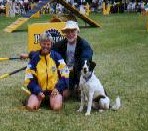 Perhaps
Guy Blancke in Belgium answered to my last question. 'If a title is something that people put
behind their dogs' names the answer is NO... we like to keep it simple.' Perhaps
Guy Blancke in Belgium answered to my last question. 'If a title is something that people put
behind their dogs' names the answer is NO... we like to keep it simple.'
Simple we aren't!
The above article is scheduled to appear in the July issue of
Clean Run, the American agility magazine. As you can see, it was meant for an American, not
English, audience! but I am sure there's something to be learned by other people's views of us.
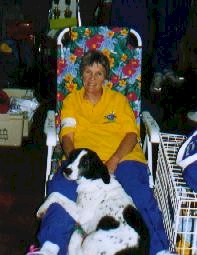 About
the author... About
the author...
Anne A. Smith lived in lived in Britain (Hadley Wood, Hertfordshire) for
three years between 1986-1989. She saw agility at Olympia, but didn't get into the sport until
1990 after she had moved back to The States. A child horse boarder (livery) began jumping Sid
(then a pup) over the horse fences, and she was hooked.
Sid, Anne's very talented Shelter rescue mix, is now 10
1/2 years old and still doing agility. He has achieved it all - AD in 1991, AAD in 1992, MAD in
1994, and ADCH in 1996. In addition, he has qualified for the Nationals many times and placed
7th in 1995 in the 24" division in San Antonio. He was in the national Top Ten in 1996.
Her new dog is Dingo, an Australian Cattle Dog Internet
rescue, who began competing last year. He has his AD and will be three years old soon. As you
can see from above, he loves to show off his contacts!
Anne now lives in Pound Ridge, New York with her husband,
horse and four 'SPCA agility kids' (That's rescue dogs to us!)
The article written by Anne Smith (above) was well
written and interesting but missed ONE huge fact. YOU STILL NEED CLEAR ROUNDS to win any
agility class. Just because we have to be very quick in the UK does not mean we miss contacts.
Okay, some couldn't get a contact if they tried.
Response: In competition
you have to be in total control of yourself and your dog, so I am afraid the nice lady was
talking like somebody who wouldn't be very competitive in the UK. I know all the people who go
to The States will say otherwise. Perhaps with the quarantine rules changing we will see who
has the best control/competitive edge etc.
David Hutchinson
|